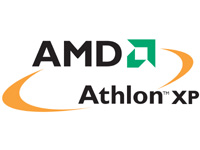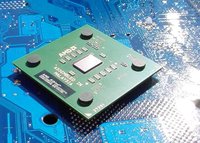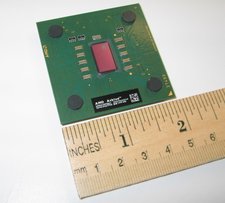Athlon
|
|
Athlon is the brand name applied to a series of different x86 processors designed and manufactured by AMD. The original Athlon, or Athlon Classic, was the first seventh-generation x86 processor and, in a first, retained the initial performance lead it had over Intel's competing processors for a significant period of time. AMD has continued the Athlon name with the Athlon 64, an eighth-generation processor featuring AMD64 technology.
| Contents |
|
|
Athlon Classic
The Athlon made its debut on August 21, 1999. The name "Athlon" was chosen by AMD as short for "decathlon". The original Athlon core revision, code-named "K7" (in homage to its predecessor, the K6), was available in speeds of 500 to 700 MHz at its introduction and was later sold at speeds up to 1000 MHz (K75). The processor was compatible with the industry-standard x86 instruction set and plugged into a motherboard slot mechanically similar to (but not pin-compatible) with the Pentium II's Slot 1.
Internally, the Athlon was essentially a major reworking of the K6 processor core designed for compatibility with the EV6 bus protocol (first used on DEC's Alpha 21264 RISC processor). AMD dramatically improved the floating-point unit from the K6 and put a large 128 KB (2x64 KB) L1-Cache on the chip. Like Intel's Pentium II and Katmai Pentium III, there was a secondary cache of 512KB, mounted externally to the chip itself but still within the CPU module, and running at a lower speed than the core: initially half-speed (up to 700 MHz), but later runs at 2/5 (up to 850 MHz) to 1/3 (up to 1 GHz) of the core speed (because of cost and availability issues with very high speed cache RAM).
The resulting processor was the fastest x86 in the world. Various different versions of the Athlon held this distinction continuously from August 1999 until January 2002.
In commercial terms, the Athlon Classic was an enormous success — not just because of its own merits, but also because the normally dependable Intel endured a series of major production, design, and quality control issues at this time. In particular, Intel's transition to a 0.18 μm production process, starting in late 1999 and running through to mid-2000, was chaotic, and there was a severe shortage of Pentium III parts. Many long-time Intel-only PC dealers found the combination of the Athlon's excellent performance and reasonable pricing tempting, and the prospect of being able to get stock in commercial volumes impossible to resist. In contrast, AMD enjoyed a remarkably smooth process transition, had ample supplies available, and Athlon sales went from strength to strength.
Athlon Thunderbird (T-Bird)
The second-generation Athlon, the Thunderbird, debuted on June 4, 2000. This version of the Athlon shipped in a more traditional pin-grid array (PGA) format that plugged into a socket ("Socket A") on the motherboard. It was sold at speeds ranging from 700 to 1400 MHz. The major difference, however, was cache design. Just as Intel had done when they replaced the old Katmai Pentium III with the much faster Coppermine P-III, AMD replaced the 512 KB external reduced-speed cache of the Athlon Classic with 256 KB of on-chip, full-speed cache. (As a general rule, more cache improves performance, but faster cache improves it further still.)
The Thunderbird was AMD's most successful part since the Am386DX-40 ten years earlier. Mainboard designs had improved considerably by this time, and the initial trickle of Athlon mainboard makers has swollen to include every major manufacturer. Their new fab in Dresden came on-line, allowing further production increases, and the process technology was improved by a switch to copper interconnects. In October 2000 the Athlon "C" was introduced, raising the mainboard front side bus speed to 133 MHz (FSB 266) and providing roughly 10% extra performance over the "B" model Thunderbird.
Athlon XP
In performance terms, the Thunderbird had easily eclipsed the rival Pentium III, and the early Pentium 4s were a long way off the pace, but gradually clawed their way closer. The 1.7 GHz P4 (April 2001) served notice that the Thunderbird could not count on retaining performance leadership forever, and thermal and electricity-consumption issues with the Thunderbird design meant that it wasn't practical to take it past 1400 MHz (even at that speed it was excessively hot).
Palomino
AMD released the third major Athlon version on May 14, 2001, code-named "Palomino". This version, the first to include the SSE instruction set from the Intel Pentium III as well as AMD's 3DNow! Professional, was introduced at speeds between 1333 and 1733 MHz. The major changes were optimizations to the core design to increase efficiency by roughly 10% over a Thunderbird at the same clock-speed, and power consumption reductions to allow it to be clocked faster.
The "Palomino" was first released as a mobile version, called the Mobile Athlon 4 (also code-named "Corvette"), after the fact that it was AMD's fourth core to be called Athlon (after the original K7, the 0.18 μm K75, and the Thunderbird), but many people noted that the name was most likely a jab at the then-brand-new Intel Pentium 4. The desktop Athlon XP followed a few months later, in October.
The "Palomino" did have one major flaw, however: it ran very hot. Its SMP enabled version, the Athlon MP entry (which carried the Palomino core before the Athlon XP), was initially hammered due to heat issues with the Palomino core.
The Athlon XP was marketed using a PR rating system, which compared its performance to an Athlon Thunderbird. Because the Athlon XP has much higher IPC (instructions per clock) than the Pentium 4 (and about 10% higher than a Thunderbird), it is more efficient and delivers the same level of performance at a lower clock-speed, or higher performance at the same speed.
Thoroughbred (T-Bred)
The fourth-generation Athlon, the Thoroughbred core, was released June 10, 2002 at 1.8 GHz, or 2200+ on the PR rating system. Two new Athlon XP's, the 2400+ running at 2000 MHz and the 2600+ running at 2083 MHz (or 2133 MHz when for 133/266 MHz front side bus), were announced on August 21. 2700+ and 2800+ Thoroughbred-core parts were also announced, but became available in insignificantly small quantities.
The "Thoroughbred" core was on a 0.13 micrometre process, unlike the 0.18 micrometre process of its "Palomino" predecessor. Other than the micrometre process, the Thoroughbred design was not different from the "Palomino" in any way. AMD did have initial troubles with the "Thoroughbred A" revision having substantial heat issues, which were solved in the "B" revision. The rev. A may have been on the 130 nm process, but it offered no real improvements over the old Palomino. Overclockers still liked to use the Palomino, even with it being made on the 180 nm process it still was able to hit higher clock speeds. The Thoroughbred "B" fixed this problem by adding an extra metal layer to the manufacturing process. AMD was able to hit speeds that would allow them to over take the market again. AMD was able to produce 2600+ at first to help them take the market from Intel. Later, AMD raised the FSB from 133 MHZ (FSB 266) to 166 MHZ (FSB 333). This allowed AMD to produce processors up to 2800+ speeds that had much power. AMD however was unable to release 2700+ and 2800+ processors in very large shipments and most were unable to get them.
Barton and Thorton
Fifth-generation Athlon Barton-core parts released in early 2003 featured PR ratings of 2500+, 2600+, 2800+, 3000+, and 3200+. While not faster than Thoroughbred-core processors in megahertz terms, they earned their higher PR-rating-per-megahertz from featuring an additional 256KB of full-speed on-chip level 2 cache and a faster FSB. The Thorton core is a variant of the Barton with half of the L2 cache disabled and thus is functionally identical to the Thoroughbred B core. Some Thortons could have the disabled L2 cache re-enabled through bridge modifications. [1] (http://www.xbitlabs.com/news/cpu/display/20030930171549.html)
Some AMD proponents claim that these new parts regained performance leadership for the Athlon, but this remained in doubt. Much controversy surrounds the benchmarks which are used to measure performance leadership. In particular, industry insiders point out that some tests have been deliberately skewed in Intel's favour—notably the BAPCo tests, which were written by Intel's own engineers.
Most observers considered that the Athlon was no longer the fastest x86 processor in the world, believing that Intel's Pentium 4 overtook the Athlon XP early in 2002 and held its lead until February 2003, with the 3.06 GHz P4 benchmarking slightly faster than the Athlon 2700+. At the time, the question was moot: AMD had yet to deliver the 2700+ and 2800+ in commercial quantities; they did not begin to ship in volume until well into the first quarter of 2003. However, as the initially troublesome transition to the 0.13 micrometre process neared completion, AMD began producing large numbers of 0.13 micrometre parts in the 1700 to 2400 speed grades (usually a sign that faster grades are not far away) and, in mid February 2003, announced the Athlon XP 3000+ to ship in volume in early March of 2003. Pending an Intel reply, the 3000+ had according to AMD reclaimed the "fastest x86 in the world" title for the Athlon once again. However reviewers' opinions on this were split, with most believing the top Intel part to still be faster.
Mobile Athlon XP
Mobile Athlon XPs (Athlon XP-M) are identical to normal Athlon XPs, apart from running at lower voltages and not being multiplier-locked. The lower vcore ratings allow the CPU to run with less power consumption (ideal for battery-powered laptops) and produce less heat. They're also capable of having their multipliers dynamically adjusted by software to supply faster speeds at higher frequencies when demanded, but throttle back to lower speeds and voltages when CPU demand is lower.
The Athlon XP-M replaced the older Mobile Athlon 4. The Mobile Athlon 4 used the older Palomino core, while the Athlon XP-M uses the newer Thoroughbred and Barton cores.
It also features Power Now! where the CPU's clock speed is automatically decreased when the computer is under a low load, to save battery power and reduce heat. Similar to Intel's SpeedStep technology.
Some specialized low-power Athlon XP-Ms utilise the µ-PGA socket rather than the standard Socket A.
Athlon XP-Ms on desktop computers became very popular with overclockers, as well as underclockers, by early 2004, in part because their multipliers are unlocked. Athlon XP-Ms are structurally identical to Desktop Athlon cousins but are singled out for their ability to operate at voltages well below normal. Since they are so efficient with voltage, they respond extremely well to increased voltages and overclock extremely well. Athlon XP-Ms overclock demonstrably better than multiplier unlocked Desktop Athlon XPs with the same "Barton" core. Some Barton core Athlon XP-Ms have been successfully overclocked to as high as 3.1 GHz.
Mobile Athlon XPs are also attractive CPUs for use in home theater systems due to their high performance and ability to underclock and undervolt for quiet operation needed in the living room.
Models
Athlon
Athlon Classic
- -> K7 "Argon" (250nm)
- -> K75 "Pluto/Orion" (180 nm)
- L1-Cache: 64 + 64 KB (Data + Instructions)
- L2-Cache: 512 KB, external chips on CPU module with 50, 40 or 33% of CPU-speed
- MMX, 3DNow!
- Slot A (EV6)
- Front side bus: 100 MHz, (FSB 200)
- VCore: 1.6V (K7), 1.6 - 1.8V (K75)
- First release: June 23, 1999 (K7), November 29, 1999 (K75)
- Clockrate: 500 - 700 MHz (K7), 550 - 1000 MHz (K75)
Thunderbird (180 nm)
- L1-Cache: 64 + 64 KB (Data + Instructions)
- L2-Cache: 256 KB, fullspeed
- MMX, 3DNow!
- Slot A & Socket A (EV6)
- Front side bus: 100 MHz (Slot-A, B-models), 133 MHz (C-models), (FSB 200/266)
- VCore: 1.7V - 1.75V
- First release: June 5, 2000
- Clockrate:
Athlon XP
Palomino (180 nm)
- L1-Cache: 64 + 64 KB (Data + Instructions)
- L2-Cache: 256 KB, fullspeed
- MMX, 3DNow!, SSE
- Socket A (EV6)
- Front side bus: 133 MHz, (FSB 266)
- VCore: 1.75V
- First release: October 9, 2001
- Clockrate: 1333 - 1733 MHz (1500+ to 2100+)
Thoroughbred A/B (130 nm)
- L1-Cache: 64 + 64 KB (Data + Instructions)
- L2-Cache: 256 KB, fullspeed
- MMX, 3DNow!, SSE
- Socket A (EV6)
- Front side bus: 133/166 MHz, (FSB 266/333)
- VCore: 1,5V - 1,65V
- First release: June 10, 2002 (A), August 21, 2002 (B)
- Clockrate:
- T-Bred "A": 1400 - 1800 MHz (1600+ to 2200+)
- T-Bred "B": 1400 - 2250 MHz (1600+ to 2800+)
- FSB 266: 1400 - 2133 MHz (1600+ to 2600+)
- FSB 333: 2083 - 2250 MHz (2600+ to 2800+)
Thorton (130 nm)
- L1-Cache: 64 + 64 KB (Data + Instructions)
- L2-Cache: 256 KB, fullspeed
- MMX, 3DNow!, SSE
- Socket A (EV6)
- Front side bus: 133 MHz, (FSB 266)
- VCore: 1.6V - 1.65V
- First release: September 2003
- Clockrate: 1667 - 2000 MHz (2000+ to 2400+)
Barton (130 nm)
- L1-Cache: 64 + 64 KB (Data + Instructions)
- L2-Cache: 512 KB, fullspeed
- MMX, 3DNow!, SSE
- Socket A (EV6)
- Front side bus: 166/200 MHz, (FSB 333/400)
- VCore: 1.65V
- First release: February 10, 2003
- Clockrate: 1867 - 2333 MHz (2500+ to 3200+)
- FSB 333: 1867 - 2333 MHz (2500+ to 3200+)
- FSB 400: 2100, 2200 MHz (3000+, 3200+)
See also
References
- This article was originally based on material from the Free On-line Dictionary of Computing, which is licensed under the GFDL.
es:AMD Athlon y Athlon XP fr:Athlon he:Athlon hu:Athlon nl:Athlon pl:Athlon ja:Athlon zh:Athlon sv:Athlon




